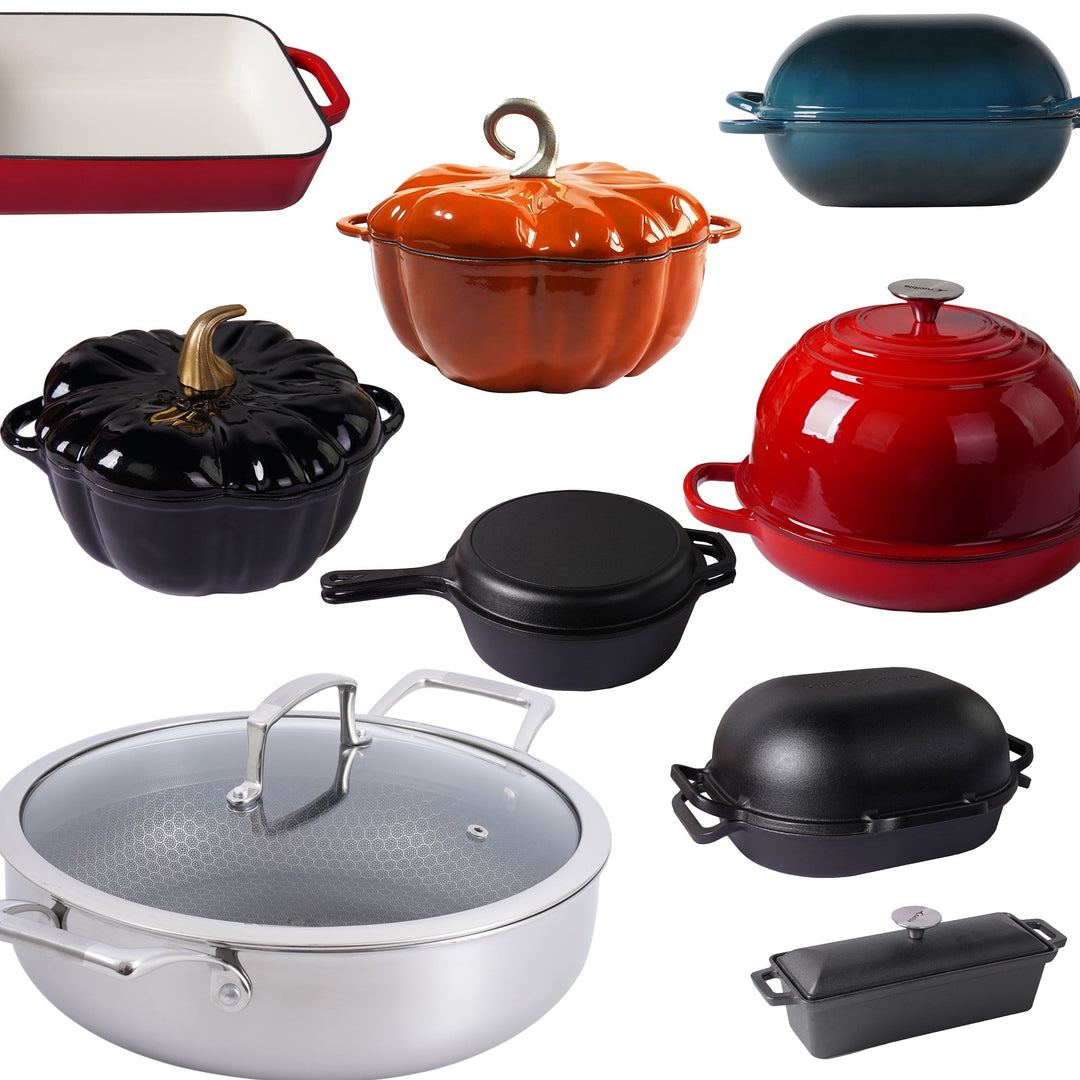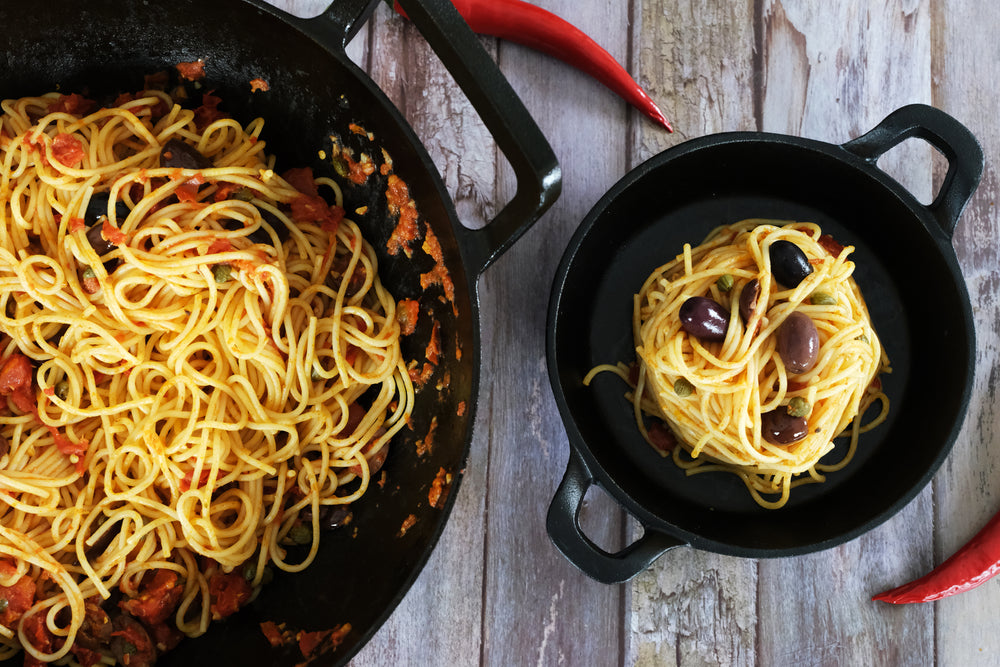كيفية اختيار المقلاة المناسبة لكل وصفة: دليل كامل لاختيار أدوات الطهي

سواء كنت مبتدئًا في المطبخ أو طاهٍ متمرس، أحد الأسئلة الشائعة التي تطرح هي: "أي مقلاة يجب أن أستخدم؟" مع وجود العديد من الخيارات المتاحة—الحديد الزهر، الفولاذ المقاوم للصدأ، غير اللاصق، وأكثر—قد يكون من الصعب تحديد الأنسب لكل طبق. اختيار أواني الطهي المناسبة يمكن أن يرفع من تجربتك في الطهي، مما يساعدك على تحقيق أفضل النكهات والقوام. في هذا الدليل، سنستعرض أنواع المقالي المختلفة، استخداماتها المثالية، وكيفية العناية بها، حتى لا تشكك أبدًا في اختيار مقلاة مرة أخرى!
1. الحديد الزهر: الحصان القوي المتين
الأفضل لـ: التحميص، القلي السريع، القلي، الخبز، والطهي البطيء.
مقالي الحديد الزهر تحظى بتقدير كبير لتعدد استخداماتها، متانتها، واحتفاظها الاستثنائي بالحرارة. يمكنها الانتقال بسلاسة من الموقد إلى الفرن، مما يجعلها مثالية للوصفات التي تتطلب التحميص على الموقد والانتهاء في الفرن، مثل خبز الذرة في المقلاة أو شرائح اللحم المحمرة في المقلاة.

-
متى تستخدم:
- تحمير اللحم: الحرارة العالية والمتساوية تخلق قشرة مثالية على شرائح اللحم، أو قطع اللحم، أو أفخاذ الدجاج.
- تحميص الخضروات: يكرمل الخضروات بشكل متساوٍ دون حرق.
- خبز الخبز أو الحلويات: استخدمه للوصفات مثل براونيز المقلاة أو خبز الذرة للحصول على قشرة مقرمشة لذيذة.
-
نصائح العناية:
- اغسل بالماء الدافئ (بدون صابون) وفرشاة ناعمة؛ تجنب فوط الفرك.
- جفف جيدًا وقم بالمعالجة بطبقة خفيفة من الزيت للحفاظ على سطحه غير اللاصق ومنع الصدأ.
-
اقتراح وصفة: بيتزا المقلاة الحديدية—احتفاظ المقلاة بالحرارة يمنح القشرة قاعدة مقرمشة مع الحفاظ على الطعوم طرية وذائبة.
2. الفولاذ المقاوم للصدأ: متعدد الاستخدامات
أفضل لـ: التحمير، إزالة الرواسب، الغليان، والطهي على نار هادئة.
المقالي من الفولاذ المقاوم للصدأ هي الخيار المفضل للعديد من الطهاة المحترفين بسبب متانتها واستجابتها لتغيرات الحرارة. توزع الحرارة بشكل متساوٍ، مما يجعلها مثالية للصلصات الحساسة، تحمير اللحوم، أو غلي المعكرونة. بدون طلاء، لا يتفاعل الفولاذ المقاوم للصدأ مع المكونات الحمضية مثل الطماطم أو النبيذ، مما يضمن نكهات نظيفة ونقية.
-
متى تستخدم:
- تحمير اللحم: رائع لبناء الرواسب (تلك القطع البنية اللذيذة التي تتكون في القاع) لصلصات المقلاة الغنية.
- إزالة الرواسب: يتم رفع الرواسب بسهولة عند إضافة السائل، مما يعزز النكهات للصلصات أو التخفيضات.
- الغليان والطهي على نار هادئة: يعمل جيدًا لصنع المرق، الحساء، أو دفعات كبيرة من المعكرونة.
-
نصائح العناية:
- استخدم قليلاً من الزيت أو الزبدة لمنع الالتصاق.
- للبقايا العنيدة، انقعها بماء دافئ وصابون أو استخدم منظف من الفولاذ المقاوم للصدأ.
-
اقتراح وصفة: دجاج بيكاتا—حمّر الدجاج في المقلاة، ثم أزل الرواسب بالعصير الليموني والنبيذ الأبيض لصنع صلصة ناعمة.
3. غير لاصق: الأساسيات للإفطار
أفضل لـ: البيض، الفطائر، الأسماك الحساسة، والطبخ منخفض الدهون.
المقالي غير اللاصقة معروفة بسطحها السهل التحرر، مما يجعلها الخيار الأفضل لطهي الأطعمة التي تميل إلى الالتصاق. وبما أنها تتطلب كمية قليلة من الزيت، فإن المقالي غير اللاصقة ممتازة أيضًا لخيارات الطهي الصحية.
-
متى تستخدم:
- طهي البيض والفطائر: احصل على التقليب المثالي دون كسر الصفار أو تمزيق الفطيرة.
- طهي الأسماك الحساسة: يمنع تفتت شرائح السمك.
- الطبخ منخفض الدهون: خيار رائع عندما تريد تقليل كمية الزيت أو الزبدة المستخدمة.
-
نصائح العناية:
- استخدم فقط أدوات من السيليكون أو الخشب أو البلاستيك لتجنب خدش الطلاء.
- تجنب الحرارة العالية؛ حافظ على متوسطة أو منخفضة لتمديد عمر المقلاة.
- اغسل يدويًا باستخدام إسفنجة ناعمة؛ تجنب غسالة الصحون.
-
اقتراح وصفة: عجة ناعمة بالأعشاب الطازجة—اطبخ على نار هادئة لعجة مطوية بشكل مثالي تنزلق بسهولة من المقلاة.
4. الحديد المطلي بالمينا: الجمال متعدد الاستخدامات
الأفضل لـ: الطهي البطيء، الطهي البطيء بالسوائل، اليخنات، والكسرولات.
الحديد المطلي بالمينا يوفر احتفاظًا بالحرارة ومتانة الحديد التقليدي، لكنه مع طلاء مينا غير تفاعلي وسهل التنظيف. هذا يجعله مثاليًا للأطباق المطهوة ببطء مثل اليخنات، والطهي البطيء، والكسرولات التي تستفيد من الطهي الطويل والمتساوي.

-
متى تستخدم:
- الطهي البطيء: الحرارة المستقرة تسمح بتفكيك قطع اللحم القاسية وتصبح طرية.
- صنع الحساء واليخنات: يحتفظ بالحرارة جيدًا للطهي على نار هادئة لفترات طويلة.
- خبز الكسرولات: ينتقل من الموقد إلى الفرن دون الحاجة لتغيير الأواني.
-
نصائح العناية:
- دع المقلاة تبرد قبل التنظيف لتجنب تلف المينا.
- استخدم إسفنجات ناعمة وصابون أطباق خفيف؛ تجنب الفُرش الخشنة.
-
اقتراح وصفة: بوف بورغينيون—هذا الحساء الفرنسي الكلاسيكي مثالي للحديد الزجاجي المطلي بالمينا، مما يسمح للنكهات بالاندماج على نار هادئة وبطيئة.
5. النحاس: أداة الطاهي المتجاوبة
الأفضل لـ: الطهي الدقيق، الصلصات، صنع الحلوى، والقلي.
أواني النحاس تستجيب بسرعة لتغيرات درجة الحرارة، مما يجعلها مثالية للوصفات التي تتطلب دقة. تسخن وتبرد بسرعة، مما يمنحك تحكمًا ممتازًا في عملية الطهي. غالبًا ما يكون النحاس مبطنًا بالفولاذ المقاوم للصدأ أو القصدير لمنع التفاعلات مع الأطعمة الحمضية.
-
متى تستخدم:
- صنع الصلصات والكراميل: التحكم الدقيق في الحرارة يمنع الاحتراق.
- قلي الخضروات: يطهو الخضروات بشكل متساوٍ وسريع دون الإفراط في الطهي.
- صنع الحلوى: مثالي للعمل مع السكر، حيث تكون درجات الحرارة المتسقة هي المفتاح.
-
نصائح العناية:
- نظف بمزيج من الليمون والملح للحفاظ على مظهره اللامع والمشرق.
- تجنب استخدامه للأطعمة شديدة الحموضة أو القلوية إذا كان الطلاء الداخلي تالفًا.
-
اقتراح وصفة: صلصة هولنديز—استخدم استجابة حرارة المقلاة السريعة لصنع صلصة هولنديز ناعمة وكريمية دون أن تنفصل.
6. الفولاذ الكربوني: خيار المحترفين
الأفضل لـ: التحميص، القلي السريع، والحصول على قشرة مقرمشة.
مقالي الفولاذ الكربوني تجمع بين أفضل خصائص الحديد الزهر والفولاذ المقاوم للصدأ: فهي خفيفة الوزن، تسخن بسرعة، وتطور طبقة معالجة غير لاصقة مع الوقت. تُستخدم عادة في المطابخ الاحترافية لتعدد استخداماتها ومتانتها.

-
متى تستخدم:
- التحمير على حرارة عالية: يطور قشرة ممتازة على اللحوم.
- القلي السريع: استخدمها بدلاً من الوعاء الصيني للطهي السريع على حرارة عالية.
- صنع الكريب: السطح الأملس مثالي للعجين الرقيق والحساس.
-
نصائح العناية:
- قم بمعالجة المقلاة بانتظام مثل الحديد الزهر.
- تجنب الأطعمة الحمضية في البداية، لأنها قد تزيل المعالجة.
-
اقتراح وصفة: لحم بقري مقلي مع البروكلي—تسمح حرارة المقلاة العالية بالطهي السريع، مما يحافظ على قرمشة الخضروات ونعومة اللحم.
اختيار المقلاة المناسبة: النقاط الرئيسية
- لطهي بدرجات حرارة عالية وسطح غير لاصق طبيعي، اختر الحديد الزهر أو الفولاذ الكربوني.
- لأطباق حساسة مثل البيض أو السمك، غير اللاصق هو خيارك الأفضل.
- للطهي البطيء والطهي على البخار، اختر الحديد الزجاجي المطلي بالمينا.
- للسيطرة الدقيقة، استثمر في أواني الطهي النحاسية.
- للطهي اليومي المتعدد الاستخدامات، استخدم الفولاذ المقاوم للصدأ.
مع المقلاة المناسبة في اليد، يصبح تحضير وتناول كل طبق أكثر متعة. جرب أنواعًا مختلفة، وسرعان ما ستكتشف المفضلة لديك لتقنيات ووصفات متنوعة. طهي سعيد!
















اترك تعليقًا